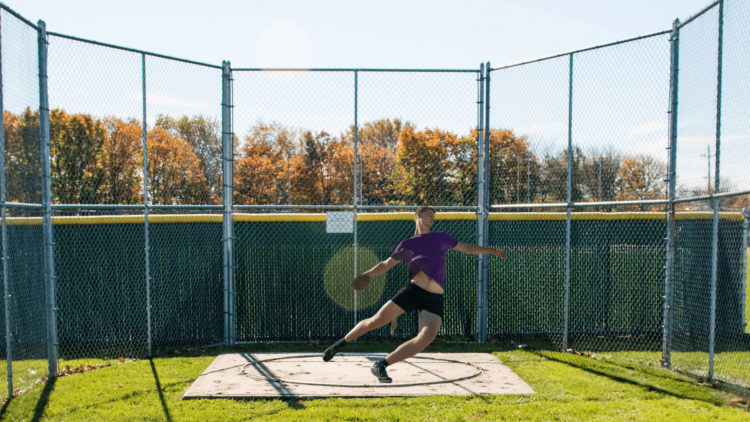
OBJECTIVE OF DISCUS: Throw a spinning discus a further distance than the other discus throwers.
NUMBER OF PLAYERS: 1+ player(s)
MATERIALS: Discus, discus cage
TYPE OF GAME: Sport
AUDIENCE: 12+
OVERVIEW OF DISCUS
Discus is an Olympic track and field event that shares many similarities to the other Olympic events of javelin and shotput. However, instead of throwing a shotput ball or javelin, athletes are tasked with throwing a frisbee-like disc as far down a field as possible.
Similarly to javelin, discus is one of the original Olympic games played in Ancient Greece, proof of which can be found in ancient statues such as Diskophoros. Interestingly, this sport wasn’t played again until the late 1800s when a German gymnastics teacher by the name of Christian Georg Kohlrausch brought the game back to prominence.
Roughly twenty years after Kohlrausch’s rediscovery, the discus throw became an official Olympic sport at the first Olympics in 1896, where it has remained an Olympic event ever since.
Initially, most discus competitors threw the disk with a technique similar to how one would throw a frisbee. However, just a few years after its first Olympic outing in Athens, Frantisek Janda-Suk discovered the rotational technique that modern-day athletes use. After just a year of practicing this technique, Janda-Suk earned a silver medal in the 1900 Olympics.
SETUP
EQUIPMENT
The Discus: A “discus” is a disk-shaped with a cross section of a circular edge, that has a metallic rim. This disk can be made of wood, fiberglass, or plastic and contain a solid or hollow core. For men, a discus should be 22 cm in diameter and weigh 4.4 pounds. For women, an 18-inch-diameter, 2.2-pound discus is used. It must not have any sharp edges or irregularities.

The Cage: In the interest of safety, discus athletes must throw inside a three-sided, U-shaped cage. The design of this structure protects all spectators and officials. It is also designed so that the disk will not ricochet back at the athlete. Additionally, this cage features a circle of 8.2 feet in diameter, marking the athlete’s throwing area. The netting point should also be a minimum of 4 meters.
GAMEPLAY
THROWING TECHNIQUE
Despite a discus’s spinning motion resembling that of a frisbee, the technique used to throw a discus is completely different. For starters, an discus thrower does not touch the bottom of the discus when throwing; instead, they place their palms on top of the discus with their fingertips resting on the sides. This method of holding makes it extremely easy for inexperienced throwers to drop the discus while attempting to throw it properly.
When throwing, an athlete spins around one-and-a-half times with their whole body while holding the discus out with a straight arm at shoulder height. This spinning motion, which is also used by shot putters, allows the athlete to generate as much momentum as possible to transfer into the item they’re throwing.
When releasing the discus, athletes should let it “roll” off their index finger, not their pinkie. Ideally, the discus should be released at shoulder height and in a straight line.
SCORING
As with all other throwing sports, Discus has a straightforward scoring system – whosever disc lands the furthest wins. Fortunately, competitors are allowed three attempts to throw the discus as far as possible.
Eventually, the top twelve competitors are awarded three more attempts at throwing the disk. It is this round which determines the final winner.
If two players tie with identical distances, both throw once more to decide the tiebreaker.
DISCUS THROWING RULES

The following faults will result in an athlete’s throw not counting on the leaderboard:
- The discus must not land outside of the designated throwing boundaries. This is foul throw as there is a particular boundary it may land in.
- After releasing the discus, the athlete must remain still and cannot step out of the designated throwing circle onto the ground beyond the circle until the discus lands on the ground.
THE LONGEST THROW
On average, Olympic-level athletes throw for distances between 195 and 230 feet. This range is essentially identical between male and female competitors, likely due to the difference in discus weight.
Both the male and female world records for the longest competitive discus throws were set in the 1980s by East German competitors Jurgen Schult and Gabriele Reinsch. Schult set the men’s record of 244 feet in 1986, while Reinsch set the women’s record of 252 feet in 1988.
Both East German records stand to this day, although some other Olympic and World Championship records have since been toppled as recently as 2022.
END OF GAME
The competitor with the longest throw at the end of the competition is deemed the victor. If multiple competitors tie with identical throwing distances, the tied athletes must perform one final throw as the tiebreaker.
- 30 GAMES TO PLAY OVER TEXT - April 22, 2024
- 20+ FREE PRINTABLE BABY SHOWER GAMES - April 16, 2024
- 20+ College Party Games for the Best Night Ever! - April 2, 2024